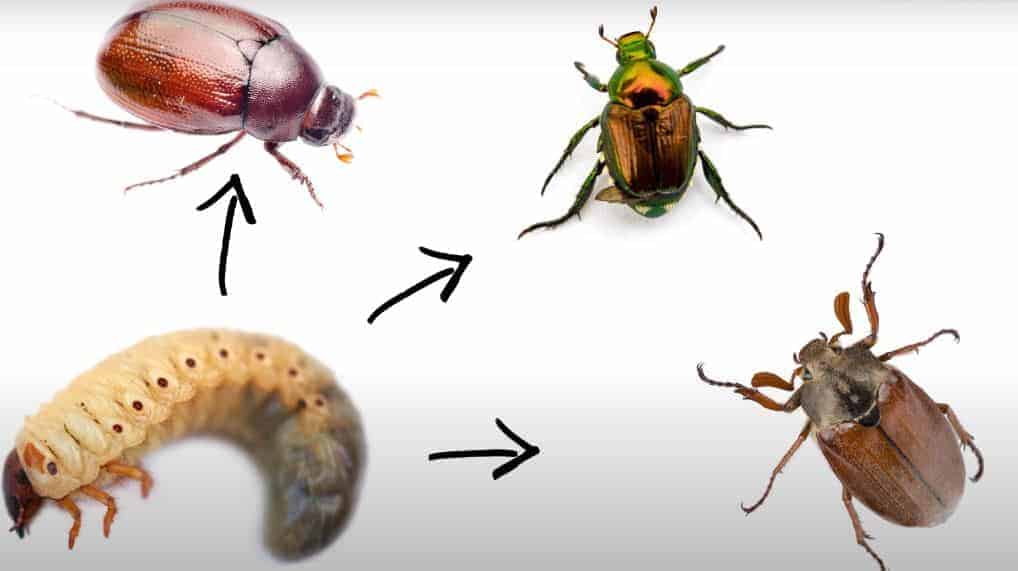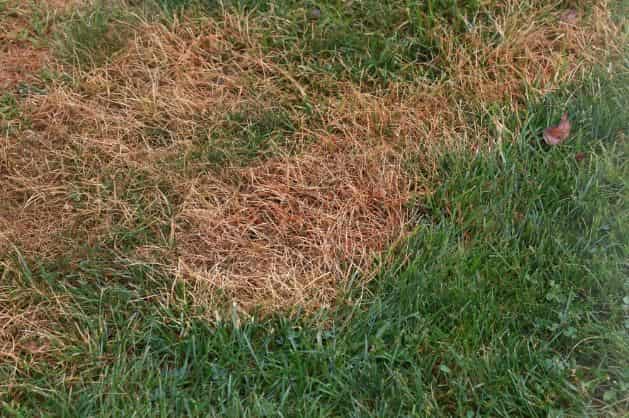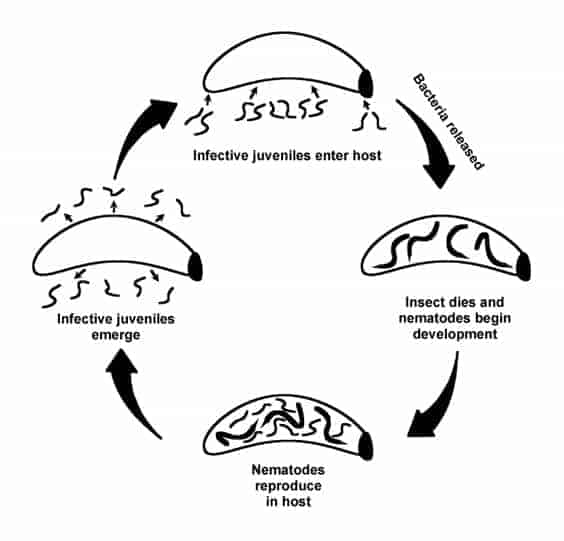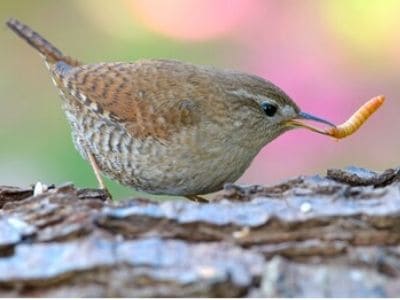If there are grubs in your lawn, you’ll start to notice a change in the shade of your turfgrass. Browning of grass during summer and early fall is a likely sign of white grubworms causing the damage.

If you fail to identify and kill lawn grubs on time, they’ll develop into pupae, and later into full-grown beetles. The beetles will later start eating lawn grass and other foliage in your yard, causing even further plant damage.
But how do you know you’re dealing with grubs in your lawn and not a disease or other problems?
DIY Lawn Care, Simplified!
Crabgrass Lawn has partnered with Sunday to get your lawn exactly what it needs to thrive. Use the code “CGLAWN20” to get $20 off.
Signs of Grub Worms in Lawn
A lawn that’s developing brown patches and showing signs of weakening could be suffering from disease. Fungal infections commonly produce brown spots, but even white grubs in your lawn can cause similar signs.
Here is a detailed article about the signs of grubs in your lawn, but I prepared a summary below, as well as tips on how to check for these destructive worms:

- Dead patches in the lawn: You’ll observe patches of brown or dead spots as the grass starts to thin out, turn yellow, and die. This occurs because grubs feed on roots, thus killing your turfgrass easily. Check out this great article I did on other causes of brown patches in lawns.
- A spongy turf: Grubs will damage the roots of turfgrass, leaving the grass easy to pull and roll up just like carpet. To test this symptom, you can do a tug test on your grass to see if it pulls up too easily.
- Increased raccoon and bird activity: Birds, moles, and raccoons feed on worms and other insects in the lawn. If you notice there’s increased activity of these predators digging your lawn, it could be a sign there are grubs in your lawn.
- Presence of many grubs in the soil: A major sign of grub infestation in your lawn is the presence of the milky-white, C-shaped worms in soil samples cut from your yard. A few of these pests shouldn’t stress your grass, but a large number of them can cause serious damage. More than 5 grubs per square foot of lawn soil will produce symptoms of white grub damage.
How to Check for Grubs in Lawn
Before you start treating, it is important to check to make sure that indeed there are grubs damaging your lawn. Irregular brown patches of dying grass are the first sign. If you see the patches, lift the turf to check for the grub worms.
Take a shovel and dig a square foot about 3 inches deep and lift the turf to check for grub worms. If you find one or two grubs is normal and healthy, but if you find 5 or more grubs, you have a grub worm infestation that needs treatment to prevent further damage to your turfgrass.
How to Get Rid of Grubs in Lawn – 7 Natural Ways
The best way to control grubs is to target them either as grub worms or when they’re adults and prevent them from laying eggs. See my article on the white grub lifecycle.
Chemical as well as natural organic options I’ve discussed below are great at killing grubs.
Here’s how to get rid of grubs worms the natural way:
#1. Apply Nematodes to Control Grubs Naturally

You can apply nematodes to get rid of grubs worms naturally and within a few days. Beneficial nematodes are very tiny roundworms that move in the moist soil under your turf and enter into the grubs where they release pathogens that attack the pests and kill them.
Here’s how to use beneficial nematodes to eliminate grubs naturally:
- Choose beneficial nematodes that work against grub worms.
- Mix the nematodes with distilled water in a lawn or garden sprayer.
- Water your lawn adequately to keep it moist.
- Spray the nematodes on a grub-infested lawn in the evening.
Pro tip: Apply nematodes only in the evening because they get killed by light and heat. Also, make sure the soil temperature is above 60°F before applying this natural treatment. Water the lawn 15-20 minutes after applying the nematodes for the best results.
Repeat the application after two weeks for the best results in controlling grubs in your lawn.
The beneficial nematodes, also called entomopathogenic nematodes, are very effective and mobile in moist environments. They seek and follow their hosts (grubs) and infect them. Soon after, the white grub population in the lawn will be destroyed. Here’s a detailed explanation on how beneficial nematodes kill grubs and other pests.
#2. Introduce Milky Spore Disease
Introducing milky spore disease in your lawn will help control the Japanese beetle larva and reduce their population naturally. The disease is applied on the turf as a dust and is very effective in controlling Japanese beetle grubs. As the grubs feed on the roots of the grass, they ingest the bacteria and get infected and die.
To get rid of white grubs in your lawn using milky spore bacteria, apply a tablespoon of the dust spacing four feet apart from each deposit. Do not use a spreader or a garden sprayer to spread. Water the treatment lightly for about 15 minutes.
Milky spore is a great natural treatment for grubs that last long – usually providing grub control for even more than 15 years. However, you should also know the limitations of using milky spore disease.
However, the results may not be immediate since it takes time for the disease to develop to full effectiveness in the turf. In cooler climates, you’ll start seeing results after a few seasons.
Once it takes effect, this grub worm fix is very effective and lasts very long, making it great for lawns with recurring instances of grub damage.
The disadvantage of using milky spore is that it only gets rid of Japanese beetle grub worms and not other species. If you have June bugs and May beetles, you might want to use other natural ways of removing them in your lawn.
#3. Encourage More Birds in Your Lawn
You might have noticed small brown birds feeding in your lawn and backyard if you have grubs in your lawn. This bird is called the House Wren.

Since these birds feed on the white grubs and other lawn insects, I would recommend encouraging them near your lawn or backyard. You can do this by providing bird houses for house wrens around your lawn.
Soon enough you’ll start seeing house wrens flying about your yard with white grub worms in their beaks. Their increased feeding activity will reduce the population of grubs in highly infested lawns.
However, this method may also cause damage since birds also start digging up the lawn to find the food. The birds may also not be able to stop large infestations of grubs.
#4. Apply Neem Oil Homemade Grubworm Killer
Neem oil has insecticidal properties and is effective in repelling grub worms in lawns and gardens. This natural pesticide deters grubs from feeding, laying eggs, and growing into adults, thus breaking their cycle and helping in their control and stopping lawn damage. Wondering how neem oil kills grubs?
To use neem oil recipe to get rid of grubs worms naturally, mix neem oil with water and spray it on a grub-infested lawn using a hose-end sprayer. Apply generously over the areas with dead patches of grass to make sure you target the larvae.
Another common homemade recipe for getting rid of grubs naturally is dawn dish soap. While it is not 100% effective at controlling grubs, it can help control mild infestations in your lawn.
To get rid of grubs naturally using dish soap, mix dawn soap with water and spray it over the infested area. The dish soaps solutions smothers and suffocates grub worms and Japanese beetles, killing them in the process. This DIY solution can also kill adult beetles and prevent them from laying eggs in your lawn.
According to the Clemson University College of Agriculture, Forestry and Life Sciences:
“Insecticidal soaps kill by suffocation, they appear to disrupt the cellular membranes of the insect, and they remove protective waxes that cover the insect, resulting in dehydration.”
#5. Limit Moisture
Grubs need soft, damp soil to survive and thrive therefore limiting moisture in the environment can help eliminate them. This is an easy, non-toxic, and natural way of killing grubs.
However, before stopping irrigation or other means to limit moisture, you should ensure that your lawn can go dormant for a few days until you can start watering again.
Take note that if you don’t water your lawn for an extended period, it will kill your grass so this method of killing grubs is only effective if your turf isn’t receiving water from rain or other natural resources.
#6. Make a Borax Grub Killer
Sodium tetraborate or Borax is an all-natural substance that can be used to kill several pests including grubs in your lawn.
However, it’s worth mentioning that Borax contains Boron, which is a chemical element that can kill your lawn in high concentrations.
If you’re going to use Borax to kill grubs, make sure that you don’t go overboard and only use a very small amount for the mixture.
To make this natural grub killer, add just 1 tablespoon of Borax to warm water in a spray bottle and apply it all over the area that has grub activity.
#7. Dethatch and Aerate Your Lawn
Thatch is a dense layer of dead and living plant organic matter.
This intermingled layer provides a great shelter for grubs so removing this welcoming environment can not only gradually eliminate grubs but can make it more easier for nematodes, milky spores, and other natural grub-killing methods to be more effective.
How to Get Rid of Grub Worms Chemically
Apply Grub Control Pesticide
Grub control insecticides that contain bifenthrin, imidacloprid, or carbaryl are very effective at killing grubs in an already established lawn.
Insecticides containing these active ingredients such as GrubEx, Merit, and Sevin are mostly systemic and kill when they come in contact with the grub worms.
There are liquid grub killers and granular grub killers on the market. Therefore, to get rid of grubs in your lawn, do the following:
- For granular pesticides, apply using the regular garden spreader and water the treatment into the soil to kill the grubs.
- For liquid grub killers, mix with water according to the label and spray the infested areas thoroughly to ensure the pesticide goes deep into the soil.
It is important to choose the best, most effective grub killer for this purpose. Scotts GrubEx is one of the industry’s most trusted grubworm destroyers.
- Scotts GrubEx1 Season Long Grub Killer can help prevent turf damage by killing grubs when they are young
- One application of this lawn care treatment kills and prevents grubs for up to 4 months
- This grub killer also controls caterpillars (armyworm), chinchbugs, May/June beetles, and more (as listed), and can help control Japanese beetle infestations when applied annually
Affiliate links and images pulled from the Amazon Product Advertising API on: 2025-07-15
However, there are other options on the market including Dominion 2L, Sevin, BioAdvanced 24 Hour Grub killer, and many others.
- INSECT KILLER OUTDOOR: Also kills Ants*, Ticks, Billbugs, Chinch Bugs, Crickets, Cutworms, Earwigs, Grasshoppers, and more (*Except Carpenter Ants, Fire Ants, Harvester Ants, and Pharaoh Ants)
- COVERAGE AREA: Outdoor ant* killer treats up to 10,000 square feet
- 24-HOUR GRUB KILLER: Deliver overnight results by killing grubs in 24 hours with this lawn pest control
Affiliate links and images pulled from the Amazon Product Advertising API on: 2025-07-15
Timing is key
When using a pesticide to control grubs, you have two options: a grub preventer, or a grub killer.
Grub killers act almost immediately, meaning you need to apply them as soon as you see lawn damage from grub worm activity. But for grub preventers, they have a lasting effect and mostly prevent grubs from the next season.
As such, make sure you apply grub control at the right time as per this guide and the label of the insecticide you’re using.
For example, Imidacloprid applications such as Merit have a long-term grubworm control effect and are best applied in April or May and will persist into August to help control annual white grubs 4 or more months later.
Bifenthrin
Bifenthrin is generally used as an insecticide to kill ants but works on grubs too. , and belongs to the pyrethroid insecticide family.
According to research from Michigan State University, Bifenthrin-only products will not kill grubs but you will have to use a pesticide with Bifenthrin and other chemicals to tackle the issue.
Imidacloprid
Preventive products that contain Imidacloprid can help eliminate between 60 percent and 70 percent grubs only if they are applied at the right time between June or July and watered in immediately after application.
Products can the active ingredient Imidacloprid have been depended on by lawn care specialists to control white grubs.
Compared to certain broad-spectrum contact insecticides that provide only moderate grub control, Imidacloprid can provide a much higher level of control per application in the growing season.
Trichlorfon
Trichlorfon works fast to kill grubs within 1 – 3 days. This organophosphate is most effective when applied in the spring or fall, and apart from grubs can also kill mole crickets, cattle lice, sod webworms, leaf miners, stink bugs, flies, ants, cockroaches.
Carbaryl
Carbaryl is an insecticide that takes a little longer than Trichlorfon to kill grubs, somewhere between 10 – 14 days after application. This man-made pesticide can also be used to control used to control aphids, fire ants, fleas, ticks, spiders, and many other outdoor
Fixing Grubworm Lawn Damage
Dead patches make the lawn look ugly, but there’s something you can do to fix them and restore your lawn to a lush green look. Grubs kill grass because they feed on the roots. If the damage is extensive, it may be difficult to attempt reviving the grass successfully.
If the damaged grass peels off the soil like carpet, then you want to consider removing the dead patches and planting new grass in the bare spots.
In general, here are options on what to do to repair the damage in your lawn:
- Rake over the dead grass to expose the soil and reseed the bare spots with new grass seed.
- If the bare spots are small and the turfgrass is not completely dead, overseed the lawn in early spring to early summer especially if it is Bermuda grass.
- Fill in the bare spots with sod if you do not want to wait for the turf to refill with new grass.
Keep in mind that before the damage occurs, it is best to prevent and control pests in your lawn. If you had any grubs in your turf last year, ensure you put down a grub killer and preventative treatment early spring to stop and prevent damage early enough.
What If It Is Earthworms?
Earthworms offer many benefits for your soil such as increasing nutrient availability and improving drainage.
Before mistaking earthworms for grubs, it is important to identify that is indeed grubs you’re trying to eliminate. Grubs are off-white in color with chubby bodies and brown heads and three pairs of legs.
Earthworms do not have much coloration and but they have lots of muscles and no skeleton. Most grub control pesticides kill earthworms so identify whether you indeed have a grub issue before application.
FAQs
Q. Should You Kill Grubs?
A. You should get rid of grubs in your lawn but only if there is a large population. One or two grubs do not require the application of a preventive product.
However, I recommend applying a grub control product at the first sign of grub damage before the situation gets out of control.
Q. What Attracts Grubs to Your Lawn?
A. There are several things that can attract grubs to your lawn, especially the healthy root system of the grass. Grubs love to much on plant roots as soon as they hatch, after which they turn into pupae and re-emerge as scarab beetles.
Q. What Time of Year Is Best for Grub Prevention?
A. The best time of year for grub prevention is April or May to control grubs that would damage your turf in the fall.
This is also a time when the grubs are ready to hatch so apply the grub control product at first sight of grubs.
Q. What Happens if You Don’t Treat Grubs?
A. Neglecting grub damage can be detrimental to turfgrass health and can cause thinning patches that will gradually increase in size.
This damaged grass can usually be pulled out easily with the roots, which indicates a weak, unhealthy root system.
Q. Is It Good to Have Grubs in Soil?
A. Grubs feast on grassroots, and eventually turn into adult beetles, after which they eat the favorable plants in your garden.
The pesky insects also enjoy nutrient-rich soil and only cause havoc in very large numbers. In terms of numbers, 10+ grubs s per 1 sq ft is considered an infestation.
Final Thoughts
Grubs feed on all types of grass and can cause extreme turfgrass damage if not controlled. There are several telltale signs of grub damage such as browsing grass, in the event of which it is best to act fast and effectively.
You can use natural remedies to kill grubs, but they aren’t as effective as chemical grub treatments.
Systemic chemicals are a quick way to get rid of grubs worms for good as grubs intake the insecticide from the plant roots.
If you have a small population of grubs, you can hand-pick them, and collect and dispose of the ones you unearth. But I still wouldn’t rely on this method alone.
When applying either natural bug killers or chemical bug killers, be careful as some of these control solutions can also kill beneficial insects and plants. For example, nematodes can be harmful to bees if they are directly exposed to them during application.
References
- HGIC Clemson Cooperative Extension: Insecticidal Soaps for Garden Pest Control
- Wikipedia: Imidacloprid Insecticide
- Iowa State University Extention and Outreach: Insecticides for White Grub Control in Turfgrass
- University of Massachusetts Amherst: Beneficial Nematodes for the Control of White Grubs in Lawns
- Penn State University: [Neem Oil] Take control of grubs in your lawn
You may be interested in…
Control & Kill Billbugs
Control & Kill Chiggers
Control & Kill Lawn Spiders
Control & Kill Ants
How to Get Rid of Mushrooms in Yard Once and for All
How Much Does TruGreen Actually Cost?
Hi, Alex Kuritz here. Growing up I remember that my family had one of the best lawns in the neighborhood. Richly green and lush. I did a lot as I grew up in terms of caring and tending for not only my family’s lawn but also my neighbors. I can say I have years of experience, and I am here to share it with you.




